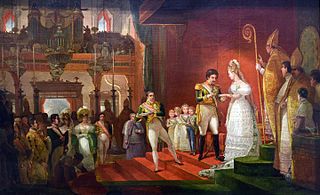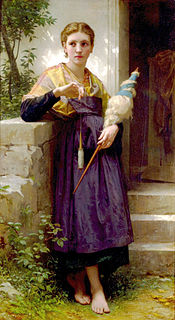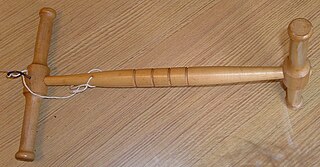Synopsis
A lazy woman did not like to spin and when she did, did not wind onto a reel, but left it on the bobbin. Her husband complained, and she said she needed a reel to do that, but when he went to cut one, she sneaked after and called out that whoever cut a reel would die. This put him off cutting it, but he still complained. She then made some yarn and said it must be boiled. Then she put some tow in the pot instead and set her husband to watch. After some time, he opened the pot, saw the tow, and thought he had ruined the yarn. From then on, the husband didn't dare complain.

A spinning wheel is a device for spinning thread or yarn from fibres. It was fundamental to the cotton textile industry prior to the Industrial Revolution. It laid the foundations for later machinery such as the spinning jenny and spinning frame, which displaced the spinning wheel during the Industrial Revolution.

A stepmother is a woman who enters one's family by marrying one's father. Children from her spouse's previous unions are known as her stepchildren.
In the textile arts, plying is a process of twisting one or more strings of yarn together to create a stronger yarn. Strands are twisted together in the direction opposite that in which they were spun. Plied yarns will not unravel, break, or degrade as easily as unplied yarns. When enough twist is added to the plies to counter the initial twist of each strand, the resulting yarn is "balanced", having no tendency to twist upon itself.
Habetrot is a figure in folklore of the Border counties of Northern England and Lowland Scotland, associated with spinning and the spinning wheel.

A spindle is a straight spike usually made from wood used for spinning, twisting fibers such as wool, flax, hemp, cotton into yarn. It is often weighted at either the bottom, middle, or top, commonly by a disc or spherical object called a whorl; many spindles, however, are weighted simply by thickening their shape towards the bottom, e.g. Orenburg and French spindles. The spindle may also have a hook, groove, or notch at the top to guide the yarn. Spindles come in many different sizes and weights depending on the thickness of the yarn one desires to spin.

"Frau Holle" is a German fairy tale collected by the Brothers Grimm in Children's and Household Tales in 1812. It is of Aarne-Thompson type 480.

"The Three Spinners" is a German fairy tale collected by the Brothers Grimm in Grimm's Fairy Tales. It is Aarne–Thompson type 501, which is widespread throughout Europe.
The Brown Bear of Norway is an Irish fairy tale collected by Patrick Kennedy which appeared in his Legendary Fictions of the Irish Celts (1866). It was later included by Andrew Lang in his anthology The Lilac Fairy Book (1910), though Lang misattributed his source as West Highland Tales.

Spinner's weasel or clock reel is a mechanical yarn-measuring device consisting of a spoked wheel with gears attached to a pointer on a marked face and an internal mechanism which makes a "pop" sound after the desired length of yarn is measured. The pointer allows the spinner to see how close she/he is to reaching a skein. The weasel's gear ratio is usually 40 to 1, and the circumference of the reel is usually two yards, thus producing an 80-yard skein when the weasel pops.

Spinning is an ancient textile art in which plant, animal or synthetic fibres are drawn out and twisted together to form yarn. For thousands of years, fibre was spun by hand using simple tools, the spindle and distaff. It was only with the invention of the spinning wheel in the Islamic world circa 1030, and its subsequent introduction to China, India and Europe in the High Middle Ages, that the output of individual spinners dramatically increased. Mass production later arose in the 18th century with the beginnings of the Industrial Revolution. Hand-spinning remains a popular handicraft.
The Two Caskets is a Scandinavian fairy tale included by Benjamin Thorpe in his Yule-Tide Stories: A Collection of Scandinavian and North German Popular Tales and Traditions. Andrew Lang included it in The Orange Fairy Book.
The One-Handed Girl is a Swahili fairy tale, collected by Edward Steere in Swahili Tales. Andrew Lang included it in The Lilac Fairy Book.
Jackal or Tiger? is an Indian fairy tale. Andrew Lang included it in The Olive Fairy Book.

The Feather of Finist the Falcon or Finist the Falcon is a Russian fairy tale collected by Alexander Afanasyev in Narodnye russkie skazki. It is Aarne–Thompson type 432, the prince as bird. Other tales of this type include The Green Knight, The Blue Bird, and The Greenish Bird.
The Snake Prince is an Indian fairy tale, a Punjabi story collected by Major Campbell in Feroshepore. Andrew Lang included it in The Olive Fairy Book (1907).
"The Myrtle" is an Italian literary fairy tale written by Giambattista Basile in his 1634 work, the Pentamerone.
Beauty and Pock Face is a Chinese fairy tale collected by Wolfram Eberhard in Chinese Fairy Tales and Folk Tales.
"The Three Aunts" is a Norwegian fairy tale collected by Peter Christen Asbjørnsen and Jørgen Moe in Norske Folkeeventyr.

A niddy-noddy is a tool used to make skeins from yarn. It consists of a central bar, with crossbars at each end, offset from each other by 90°. The central bar is generally carved to make it easier to hold. Either one of the crossbars will have a flat edge to allow the skein to slide off, or will be completely removable. Niddy-noddies can be constructed of many different materials including wood, metal, and plastic. Wood is traditional, and most quality niddy-noddies are still made of wood. Budget spinners occasionally use niddy-noddies made from PVC pipes.
Textile manufacturing is one of the oldest human activities. The oldest known textiles date back to about 5000 B.C. In order to make textiles, the first requirement is a source of fibre from which a yarn can be made, primarily by spinning. The yarn is processed by knitting or weaving to create cloth. The machine used for weaving is the loom. Cloth is finished by what are described as wet process to become fabric. The fabric may be dyed, printed or decorated by embroidering with coloured yarns.








